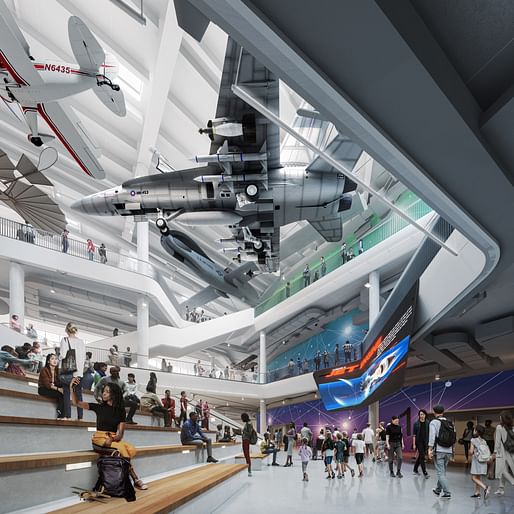
ZGF Architects has unveiled details of its Samuel Oschin Air and Space Center, which has just broken ground in Los Angeles. The 200,000-square-foot facility will house 150 exhibits across three multi-level galleries and will serve as the permanent home of Space Shuttle Endeavour, one of three remaining flown space shuttle orbiters.

The scheme, designed by ZGF with engineering by ARUP, is arranged around three thematic galleries, named Air, Space, and Shuttle. The Air Gallery will explore the four physical forces behind flight: lift, thrust, drag, and weight. Approximately 20 aircraft will be on display in the gallery, including a segment of a real Boeing 747. The Air Gallery will also feature a wind tunnel exhibit to allow visitors to better understand the forces under which planes fly.

The Space Gallery centers on the various machines and inventions created to understand and explore space, including telescopes, robots, and spaceships. Among the exhibits are a SpaceX Dragon capsule, an Apollo Command Module, and an array of engineering models of probes, telescopes, and spacecraft.
The Shuttle Gallery will showcase Space Shuttle Endeavour, representing the world’s first reusable spacecraft program. Rising 20 stories to a maximum height of 200 feet, the gallery will contain the flown shuttle along with its solid rocket boosters and external tank, all in a vertical ‘ready to launch’ configuration. The gallery thus contains the only complete stack of space shuttle flight hardware in the world.
The new scheme is the final phase of the California Science Center’s three-phase, three-decade master plan to develop a comprehensive educational center across LA’s Exposition Park. When the ZGF center is completed, it will almost double the California Science Center’s educational exhibit area.
Construction of the scheme is expected to take three years. 18 months into construction, the Space Shuttle Endeavour will be positioned inside the center, with the remaining building elements completed around the full shuttle stack.
News of the project comes amid a series of space-themed architectural news. Last month, the MIT Media Lab designed and tested modular tiles which can self-assemble in outer space, with the ultimate goal of creating habitats on the Moon, Mars, and in orbit. In March, NASA awarded grants to three universities to develop lunar infrastructure, while space construction company Orbital Assembly unveiled plans for the world’s first space hotel.
In sadder news, May also saw news of the death of Colin Cantwell, the architecture lover who designed the Death Star, and many other iconic Star Wars spacecraft.
1 Comment
Technically, there's FOUR orbiters but one of them is not equipped with the engines or tiles but those parts were available to be installed on the Enterprise but then used in the Endeavor. Of course, over the years, spare engine and tile parts existed since. The parts to make the Enterprise fully operational were made, it was just not used during certain tests.
3 of the Orbiters that are fully operational for space flight were made but they had the parts for the Enterprise but it wasn't used so it's probably the most structurally sound of all the orbiters that remain.
Block this user
Are you sure you want to block this user and hide all related comments throughout the site?
Archinect
This is your first comment on Archinect. Your comment will be visible once approved.